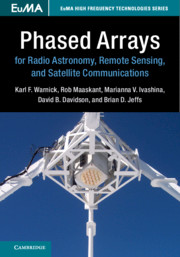Book contents
- Frontmatter
- Contents
- Preface
- Acknowledgements
- Notation and Units
- 1 Phased Arrays for High-sensitivity Receiver Applications
- 2 Active Antenna Receivers
- 3 Antenna Examples
- 4 Transmitting Arrays, Network Analysis, and Pattern Overlap Integrals
- 5 Array Receiver Theory and Modeling
- 6 Figures of Merit for Active Receiving Arrays
- 7 Design and Optimization of Phased Array Antennas
- 8 Numerical Modeling of Phased Array Antennas
- 9 Analog Front End, Array Elements, and Receiver Electronics
- 10 Array Signal Processing, Calibration, and Beamforming
- 11 Interferometric Arrays and Synthesis Imaging
- 12 Real Time Digital Signal Processing
- Index
- References
7 - Design and Optimization of Phased Array Antennas
Published online by Cambridge University Press: 14 July 2018
- Frontmatter
- Contents
- Preface
- Acknowledgements
- Notation and Units
- 1 Phased Arrays for High-sensitivity Receiver Applications
- 2 Active Antenna Receivers
- 3 Antenna Examples
- 4 Transmitting Arrays, Network Analysis, and Pattern Overlap Integrals
- 5 Array Receiver Theory and Modeling
- 6 Figures of Merit for Active Receiving Arrays
- 7 Design and Optimization of Phased Array Antennas
- 8 Numerical Modeling of Phased Array Antennas
- 9 Analog Front End, Array Elements, and Receiver Electronics
- 10 Array Signal Processing, Calibration, and Beamforming
- 11 Interferometric Arrays and Synthesis Imaging
- 12 Real Time Digital Signal Processing
- Index
- References
Summary
In this chapter, we turn from the theory of arrays and array feeds and analysis methods to the design of phased array antennas. As in Chapter 10, the application focus is primarily on radio astronomy, since these are often the systems with the most challenging specifications – due to the extremely weak signals involved. As indicated in Chapter 1, phased arrays in radio astronomy are used in two quite distinct configurations: aperture arrays (AAs), and phased array feeds (PAFs). Recapping briefly, AAs have a direct view of the sky, whereas PAFs lie in the focal plane of a reflector. The design considerations for AAs and PAFs diverge substantially.
AAs tend to involve very large numbers of elements (the EMBRACE system to be discussed contained around 20 000 elements, and SKA1-LOW is planned to have more than 100 000), whereas PAFs usually involve tens or hundreds of elements. For AAs, there are important system considerations, including whether a sparse or dense configuration should be adopted, and additionally, whether the topology of the array should be regular or random (irregular). These choices are usually driven by the desired application(s) – which in radio astronomy are the science cases – and of course cost. In particular for AAs operating at the lower radio astronomy frequencies (typically the VHF radio band), the radio sky is so noisy that these systems are sky noise dominated, permitting different design optimizations. For some of these designs, infinite array analysis offers useful design information. Furthermore, for a typical radio telescope, the clustering of elements into stations, and the overall layout of these stations for interferometric imaging (the topic of Chapter 11) are also important design issues, requiring optimization.
PAFs generally operate in a different milieu in radio astronomy, typically in the UHF bands (and higher). Here, very high performance and ultra-low noise characteristics are crucial, the number of elements is limited, edge effects of finite arrays are very important, and the full theory developed earlier in this book must be brought to bear on their design. Additionally, the interaction with the reflector must also be included. Many of these systems are retro-fitted to existing dishes, so the interferometric imaging considerations have already been addressed in the original design, but there are newbuilds with PAFs – most notably ASKAP – where this must also be taken into account.
Information
- Type
- Chapter
- Information
- Publisher: Cambridge University PressPrint publication year: 2018
